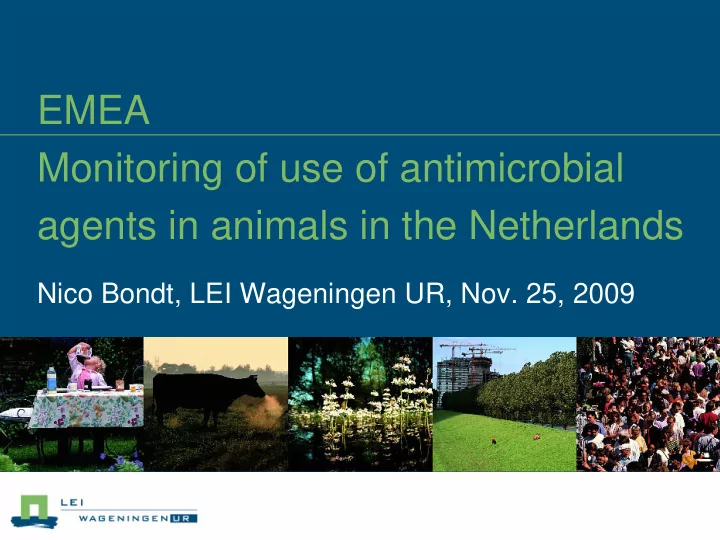

EMEA Monitoring of use of antimicrobial agents in animals in the Netherlands Nico Bondt, LEI Wageningen UR, Nov. 25, 2009
Content � Legal basis for collection of data in NL � Distribution of veterinary antimicrobial agents � Data sources for collection of data � Reporting of data (i.e. annual report) � Difficulties to perform sales surveys
Legal basis for collection of data in NL All current monitoring systems in NL are voluntary, there is not yet a legal basis for monitoring of use of antibiotics � EU DIRECTIVE 2003/99/EC of 17 November 2003 on the monitoring of zoonoses and zoonotic agents provides no legal basis for monitoring of use of antibiotics
Distribution of veterinary antimicrobial agents In The Netherlands veterinary antibiotics are sold to the end users (farmers) almost exclusively by veterinarians
Data sources for collection of data � Monitoring of sales data, collected by members of FIDIN (group of manufacturers and importers) � Start of monitoring: 1998, 1999 � Monitoring of purchased antibiotics on farms in FADN data network, by LEI Wageningen UR � Start of monitoring: 2004 � Five private initiatives with first reports in 2010 � i.e. combination of digital receipts of vets and private quality system IKB
Format for collection of sales data (Vetindex) Vetindex name Name of the article � Vetindex code 9-digit code, unique for Vetindex � EAN code Code on the product label, from EAN Nederland/België (GS1). � HIBC code Barcode of the European Health Industry Business Communication Council (EHIBC). � Packing Packing of the article, such as ampoule, bottle, box etc. � Administration Injectable, aërosol, tablet, oral powder, etc. � Size of packing For example: 10 ml. Note: 10. � Unit of packing For example: 10 ml. Note: ml. � Date of introduction The date of introduction of the article into the market. � Date withdrawal The date of the withdrawal of the article from the market. � Therapeutic class Category of veterinary classification of the article. � Registration number Code of the registration for the government (code with digits and letters) � Status POM, non-POM � Price Wholesale prices � Active substance Name or names of the active substance(s) in the article. � Concentration The concentration per active substance in the packing. � Concentration unit Unit of the concentration, for example mg active substance per g of product. � Total active subst. Calculation of the total amount of active substance(s) in the packing. � Unit of total act.sub. Always: grammes. � Source: FIDIN (summarized overview)
Reporting of data (annual reports) � FIDIN: Annual report of total sales of veterinary antibiotics (kg) percentage of cover of the total market: 95% � Wageningen UR: Annual report of number of defined daily dosages per animal per year specified data per sector 159 farms in Farm Accountancy Data Network data about veterinary medicines: University of Utrecht
Difficulties to perform sales surveys � Total sales in kg of antibiotics gives no insight in real exposure to antimicrobial agents � Amounts of different active ingredients cannot be totalled ! ( for example: Oxytetracyclines: 28 mg active substance per kg live weight, Doxycycline: 9 mg per kg) � Amounts of use in different sectors cannot be totalled ! (Oxytetracyclines in pigs 26 mg /kg, in veal calves 37 mg /kg) � Wageningen UR: Annual report of number of daily dosages per animal per year � Small sample of livestock farms: appr. 50 farms dairy, 90 pigs and 30 broilers (plus 230 veal calves) � Only pigs, broilers, veal calves, dairy cattle (no sheep, goats, turkeys etc.)
Conclusion For monitoring on (inter)national level is needed: 1. data about sales of antimicrobial agents (kg), as detailed as possible 2. data about sizes of livestock (kg) 3. conversion from kg antibiotics to kg of animals treated (if possible per individual product) 4. calculation of exposure: defined daily dosages per average animal per year
Thank you for your attention Moreinformation: - www.cvi.wur.nl MARAN 2007 report - www.lei.wur.nl LEI reports 2009-015 and 2009-065 - www.fidin.nl FIDIN report 2008 - contact Nico Bondt, LEI Wageningen UR: nico.bondt@wur.nl
Recommend
More recommend